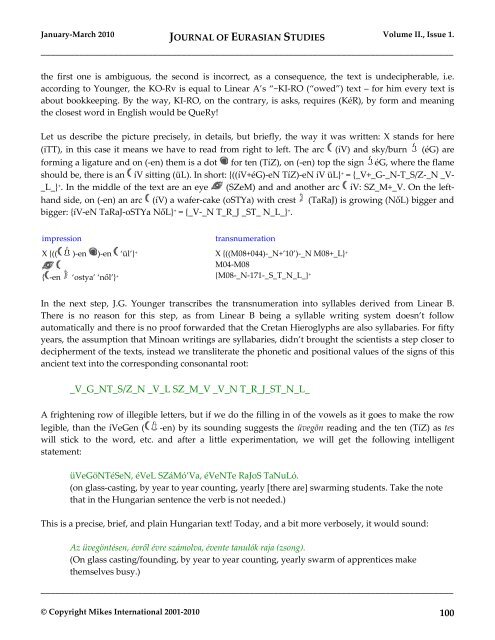EurasianStudies_0110..
EurasianStudies_0110..
EurasianStudies_0110..
You also want an ePaper? Increase the reach of your titles
YUMPU automatically turns print PDFs into web optimized ePapers that Google loves.
January-March 2010 JOURNAL OF EURASIAN STUDIES Volume II., Issue 1.<br />
_____________________________________________________________________________________<br />
the first one is ambiguous, the second is incorrect, as a consequence, the text is undecipherable, i.e.<br />
according to Younger, the KO-Rv is equal to Linear A’s “~KI-RO (“owed”) text – for him every text is<br />
about bookkeeping. By the way, KI-RO, on the contrary, is asks, requires (KéR), by form and meaning<br />
the closest word in English would be QueRy!<br />
Let us describe the picture precisely, in details, but briefly, the way it was written: X stands for here<br />
(iTT), in this case it means we have to read from right to left. The arc (íV) and sky/burn (éG) are<br />
forming a ligature and on (-en) them is a dot for ten (TíZ), on (-en) top the sign éG, where the flame<br />
should be, there is an íV sitting (üL). In short: {((íV+éG)-eN TíZ)-eN íV üL} + = {_V+_G-_N-T_S/Z-_N _V-<br />
_L_} + . In the middle of the text are an eye (SZeM) and and another arc íV: SZ_M+_V. On the left-<br />
hand side, on (-en) an arc (íV) a wafer-cake (oSTYa) with crest (TaRaJ) is growing (NőL) bigger and<br />
bigger: {íV-eN TaRaJ-oSTYa NőL} + = {_V-_N T_R_J _ST_ N_L_} + .<br />
impression transnumeration<br />
X {(( )-en )-en ‘ül’} +<br />
{ -en ‘ostya’ ‘nől’} +<br />
X {((M08+044)-_N+’10’)-_N M08+_L} +<br />
M04-M08<br />
{M08-_N-171-_S_T_N_L_} +<br />
In the next step, J.G. Younger transcribes the transnumeration into syllables derived from Linear B.<br />
There is no reason for this step, as from Linear B being a syllable writing system doesn’t follow<br />
automatically and there is no proof forwarded that the Cretan Hieroglyphs are also syllabaries. For fifty<br />
years, the assumption that Minoan writings are syllabaries, didn’t brought the scientists a step closer to<br />
decipherment of the texts, instead we transliterate the phonetic and positional values of the signs of this<br />
ancient text into the corresponding consonantal root:<br />
_V_G_NT_S/Z_N _V_L SZ_M_V _V_N T_R_J_ST_N_L_<br />
A frightening row of illegible letters, but if we do the filling in of the vowels as it goes to make the row<br />
legible, than the íVeGen ( -en) by its sounding suggests the üvegön reading and the ten (TíZ) as tes<br />
will stick to the word, etc. and after a little experimentation, we will get the following intelligent<br />
statement:<br />
üVeGöNTéSeN, éVeL SZáMó’Va, éVeNTe RaJoS TaNuLó.<br />
(on glass-casting, by year to year counting, yearly [there are] swarming students. Take the note<br />
that in the Hungarian sentence the verb is not needed.)<br />
This is a precise, brief, and plain Hungarian text! Today, and a bit more verbosely, it would sound:<br />
Az üvegöntésen, évről évre számolva, évente tanulók raja (zsong).<br />
(On glass casting/founding, by year to year counting, yearly swarm of apprentices make<br />
themselves busy.)<br />
_____________________________________________________________________________________<br />
© Copyright Mikes International 2001-2010 100

















